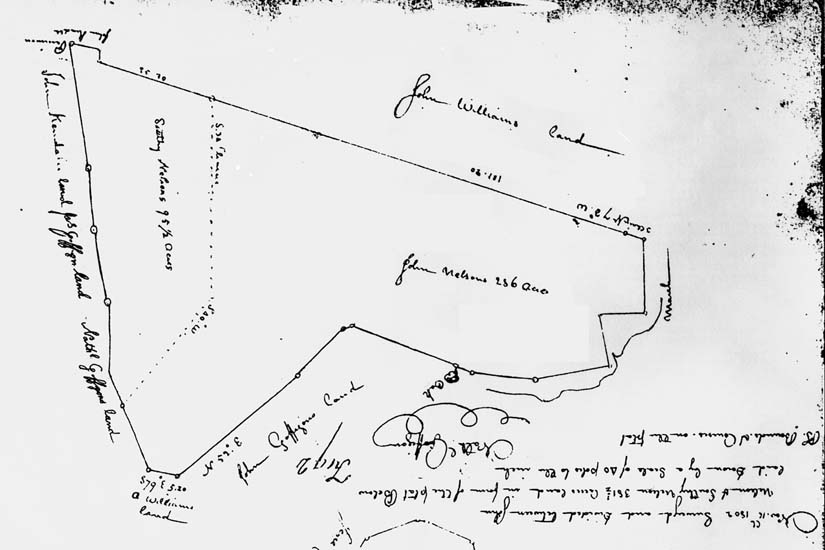
Southy Nelson (1781-1812) and Sally Joynes Brickhouse (1783-1859)
©1997 Will Brown
Among many legacies in his will of 1739, William Willett bequeathed to his fatherless grandson, Thomas Willett:
" the plantation whereon Frances Stokley now liveth containing four hundred acres of land more or less bounded easterly upon the Seaboard Side Southerly upon Kill point branch & from head of Kill point branch among a line of marked trees to the head of a small valley & to the North bounds of my eleven hundred Acres of Land bounded Westerly on a line marked trees running from my North bound of eleven hundren acres of land near the Plantation where Thomas Clay now liveth to a White Oak on
Will Book 26 p. 390
Northampton Co, Va.
The Will of Southy Nelson
In the Name of God Amen. I Southy Nelson being Sick and weak of body, but in perfect Sense and Memory, thanks be to God for the same.; I do hereby make and ordain this my last Will and Testament in manner and form following Viz.
Item I give and bequeath unto my brother John Nelson my Gun that he has now and my new hatt and my gray Coat, Red Vest and blue breeches.
Item I give and bequeath to my Sister Molly Freshwater Ten barrels of Corn.
Item I give and bequeath to my loving wife Elizabeth Nelson, after paying off the Legacies and all my Just Debts, the remainder part of my Estate be it in whatsoever kind it may untill my son John Nelson comes to lawful age for to bring up my Children upon. If my wife should marry or die before my son John Nelson comes of age, my desire is that they should then come to an equal Division betwen my wife Elizabeth Nelson and all my children namely William Nelson, John Nelson and the child my wife goes with.
And lastly I do hereby Nominate Constitute and appoint my loving wife Elizabeth Nelson and Southy Goffigon to be my Executrix and Executor of the My last Will and Testament. In Witness whereof I have hereunto Set my hand and Seal this 6th day of January 1781.
Southy [X] Nelson
Signed sealed & acknowledged inthe presence of
Southy Goffigon, Lucretia [X] Fathery
At a court held for Northampton County the 14th day of February 1781.
This Will was proved by the oath of Southy Goffigon and Lucretia Fathery witness thereto and ordered to be recorded; And upon the motion of Southy Goffigon the Ex. and Elizabeth Nelson Exx. therein apointed, And they having given bond with security and taken the oath according to Law, A Certificate is granted them for obtaining a Probate thereof in due form.
Exad. Test
the South bounds of Thomas Benthalls Land near the Head of Stokley's land to him my said Grandson Thomas Willet and the Heirs lawfully begotten of his Body forever"
Thomas died in 1751 leaving a wife Tabitha and three children: William,
Elizabeth and Ann. In his will he gave his land to his son William. William
died intestate in 1773 and Ann must have preceded him intestate and without
heirs, for William Willett's other sister Elizabeth, being the only surviving
heir, inherited the land. In 1770, before William's death, Elizabeth had
married Southy Nelson, the son of John Nelson and Elishe Jacob. According
to the laws of the time, any property that a wife inherited became the property
of her husband.
When the elder Southy Nelson died in 1781, the younger Southy was mentioned
in his will only as the unborn child:
"after paying off the Legacies and all my Just Debts, the remainder part of my Estate be it in whatsoever kind it may untill my son John Nelson comes to lawful age for to bring up my Children upon. If my wife should marry or die before my son John Nelson comes of age, my desire is that they should then come to an equal Division between my wife Elizabeth Nelson and all my children namely William Nelson, John Nelson and the child my wife goes with."
However, on the 31st of May 1781, a month before Southy was born, his mother deeded the land to his two brothers, William and John, possibly fearing the dangers of childbirth and also to divide the land according to her wishes. If she had died in childbirth, the newborn child would have been left in a disadvantage if it survived. Her decision could imply that she was more concerned about her two living sons. The eastern portion with the mansion house was deeded to William, the eldest son, and the western end with a house in tenure of Thomas Downs, was deeded to John.
The Southy Nelson I house, known as the Al Wise house
On the 29th of June, 1781 Southy Nelson was born. Southy inherited one fourth of the value of slaves Nanny and Stephen from his father's estate together valued at £55. He was due from his father's estate one fourth of the balance after debts were paid which would have been about £67. But this was held up in probate and apparently wasn't available for his maintenance and wasn't paid until after the estate of John Nelson, their uncle, was settled in 1802 or later.
In February of 1783, Elizabeth Nelson, the widow, married Stuart Holt. In October 14th of that year the court of Northampton appointed him the guardian of the three Nelson children. However, on the 13th of November, Southy Goffigon brought a motion before the court that a new guardian be appointed. The court then ordered the sheriff to summon Holt to appear at the next session of court to see if Holt objected to his removal. By November 29th of that year, John Nelson, the infants' uncle, became their guardian.
The orphan accounts of Southy show that his total expenses for the years 1783 to 1789 was a little over £45. His only income was from the hire of his negro, Nanny, which netted about £10 for those seven years, leaving a balance of £35 due his guardian. Stephen, his other slave was not mentioned in the accounting; he may have not been hired out, but employed in the household in which Southy lived for those years. The greatest expense was his board of £9 per year - unfortunately the accounts did not say to whom the money is paid. Other expenses were entirely for articles of clothing or the materials needed for their making. In contrast, William's surplus for those years was a little over £108 and John's was £88. This was despite major construction on William's property and the construction of a kitchen on John's. In 1790, with the death of his brother William, Southy acquired half of his land and half of his slave, George. With new affluence, Southy began his schooling for the first time. In 1790 his account shows a slight surplus of little over £2.
Southy's accounting makes no mention of any maintenance to a dwelling, while in John's account, and in William's before his death, entries show constant repair and construction. This could indicate that no building had been built on Southy's land, and that both houses were on John's land.
In or before 1790, Stuart Holt, the stepfather died. The lack of mention of a surviving wife in the administration of Holt's estate implies that Elizabeth Willett Nelson Holt, their mother, had preceded him.
In 1799, John Nelson, Southy's uncle and guardian, died. Southy's brother John, now of age, was appointed his guardian.
After Southy turned 21 in 1802, the land was surveyed by Nathaniel Goffigon. The land which was owned by his brother William was divided equally between the surviving brothers, each receiving equal amounts. Southy, who had no land before now had 96 1/2 acres to John's 286 acres. A deed of exchange in 1804 allowed them re-divide the land, not as their mother had divised, but giving John the mansion house, and possibly the tenant house, on the eastern portion, and Southy the smaller western portion. This division is shown on the 1802 survey.

Land plat showing the division of the land between John and Southy Nelson as surveyed by Nathaniel Goffigon in 1802. This plat presumably shows the land that William Willett bequeathed to his grandson Thomas Willett in 1739.
* * * * * * * *
About this time, or before Southy became of age, a house may have been built on his land. Since there are no orphans accounts for the years from 1793 to 1802, there is no definite proof of this.
On November 17, 1803, Southy Nelson and Sally Joynes Brickhouse were married. Sally was the daughter of George Brickhouse and Mary Belote. George and Mary Brickhouse owned land near Marionville, and Sally was probably born there. Southy and Sally had four daughters: Elizabeth W., who was born in May of 1805; Mary S., born June, 1807; Margaret B., born November 1809; and Maria Joynes, born in October of 1812.
On the 13th of December, 1812, Southy died intestate age 31, leaving a 29 year old widow and four daughters, all under seven years of age - one just seven weeks old. John Nelson, his brother , was the administrator of Southy's estate. At the time of his death Southy owned two slaves, Stephen and Nanny, whom he had inherited from his father. Ben, Rachel and Nilly were listed as well, inherited in 1808 by Sally from her grandfather, John Brickhouse.
From information found in his inventory of his estate, it is evident that they farmed the land raising corn and flax. Animals were kept for food and perhaps as a source of cash. Smoked pork, (listed as bacon in the inventory) 575 pounds of it, could have been for their own use for there was not a large inventory of pigs. From all indications their house was a modest one. Probably two rooms downstairs, one containing a bed with a trundle. The room had two windows with curtains. The other room was most likely a combination room used for eating and assembling. In this room was Southy's mahogany desk where the farm accounts would have been kept. There was a mahogany table with windsor chairs, a cherry cupboard or buffet in which were stored the simple green and blue edged china, serving dishes, silverware, and other eating utensils. There was also a green painted chest and a mirror hung on the wall. There was a sparse library of two books. A lone fireplace for heat was equipped with a shovel, andirons, and tongs. Two bedrooms were upstairs. Separate from the house were the kitchen and the smokehouse, a barn for the animals and storage of farm implements, grain and feed, and separate quarters for the nine slaves.
An intriguing item inventoried with a canoe, complete with sails and rigging, was a set of steelyards. The canoe could have served as a means to supplement Southy's farming by fishing, crabbing, oystering, etc. The steelyard was to weigh the catch. The canoe was probably a log canoe of type which had been on the shore for a hundred years or more and exist up until this day. Built of three or five logs secured together and carved into the shape required, the canoe sold for $4.00, perhaps tells of its condition.
The appraised value of Southy's goods was £245.8.3. The slaves were separately valued at £440. The $780.51 realized from the sale the next day exceeded the appraisal. The slaves were not included in the sale and were often divided among the heirs by the commissioners appointed by the court for that purpose; however, since all the heirs, except the widow, were underage, the slaves were probably not divided at this time. It seems unusual that the appraisal was valued in pounds while the sale, which was held the next day, was accounted in dollars.
The final accounting of Southy's estate was not made until eleven years after the sale in April, 1825. The total amount raised from the sale and the interest accrued came to $1318. After the expenses and the debts were paid, there remained a balance of $1195.
Inventory, estate sale and final accounting of Southy Nelson II
* * * * * * * *
Sally's purchases at the sale indicate that she wished to continue to farm and raise the children on their farm. Sally tried to hold onto things as they were. Perhaps this was not too difficult as long as she didn't marry or her children remained under age and unmarried as well. After all, she and her daughters had inherited the slaves who had worked the land and did the required chores as before. Since Southy had died intestate, by law her dower interest was one-third of the property and the children were entitled to the other two-thirds.
In 1831, Sally along with her living siblings, John and George Brickhouse, Margaret Turner, and Jenny Ward, brought suit against the infant children of her deceased sister Polly Dunton: George, Mary and Elizabeth Dunton. The intent of the suit was to divide the 400 acres of land that they had inherited from their recently deceased father, George Brickhouse. The court ordered that commissioners be appointed to divide the land equally among the petitioners and the defendants. The commissioners decided that each party should receive one share. The share of the defendants (the Dunton children) was not to be divided, but to be held in common. By November of 1831 a partition had taken place and that a plat was ordered to be drawn. The order stipulated that the Dunton children had six months after they became of age to challenge the division.
Order to divide the land of George Brickhouse, decd.
In March of 1832, John Carpenter, who had married daughter Elizabeth four years before, brought a suit, with sisters Maria Nelson and Margaret Nelson against their sister Polly Nelson asking that the Nelson land be divided and sold. In May of 1832, the Northampton County Court ordered that George Brickhouse, Sally's brother, be appointed as commissioner and advertise the land for public auction. The court determined that the land would be of little value if it was divided, and the sale would be in their best interest. The sale was so advertised with notices placed on the court house door and at the store of Goffigon & Segar, near the premises. They also determined that Sally's interest in the land was one-eighth the value. The sale was held, and John Griffith, Jr., was the highest bidder of $1138. In June of 1832, Sally sold her dower interest in the land to Griffith for $162.60.
In November of 1832, Sally Nelson with her brother John Brickhouse, Edward Turner, in right of his wife Margaret, Jessie Harrison, Jane's new husband, for her right, and the Dunton children, brought suit against their brother and uncle George Brickhouse, the executor of their father George's estate. This suit was for the division of his slaves. The court ordered that the division be made into six lots as evenly as possible: one lot to each of the surviving siblings and one lot to the three children of Polly Dunton.
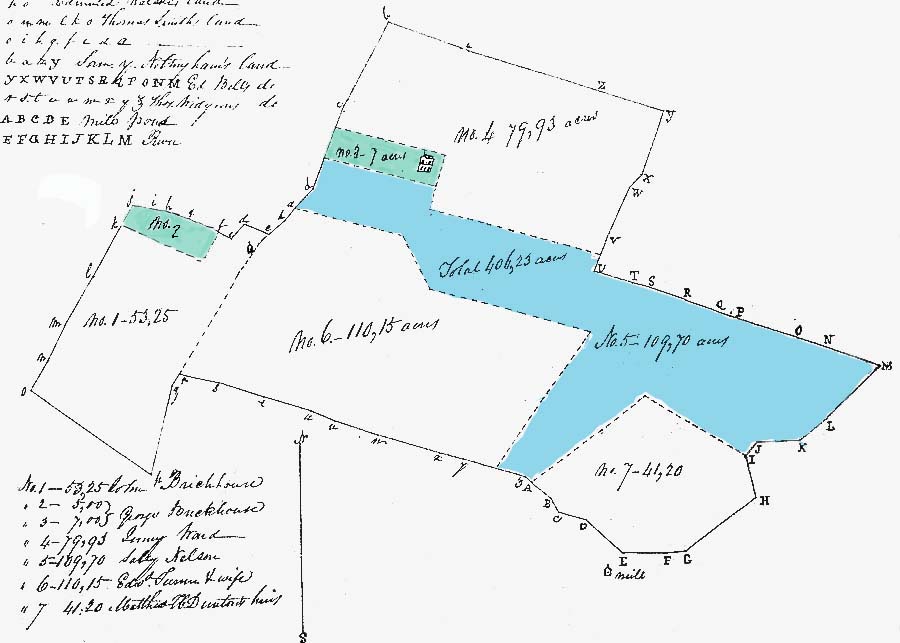
Plat showing the division of the land of George Brickhouse the elder. Divisions shown in green were those allotted to George Brickhouse, the younger and later sold to his sister, Sally Brickhouse Nelson in 1833. Sally 's original alloment is shown in blue.
In May of 1833 Sally purchased from her brother George Brickhouse and his wife Ann (Sanford) two parcels of land of seven and five acres in Red Bank for $600. These two portions were George's part of his father's land. The five acre piece, which was on the western side of the Seaside Road, was sold by Sally four years later to James Benston for $70. The seven acre piece, shown as No. 3 on the above plat, contained a house. This house is Liberty Hall built in 1820, probably by George Brickhouse the elder. The house stands today and has been continuously occupied by the direct descendants of Southy and Sally Nelson.
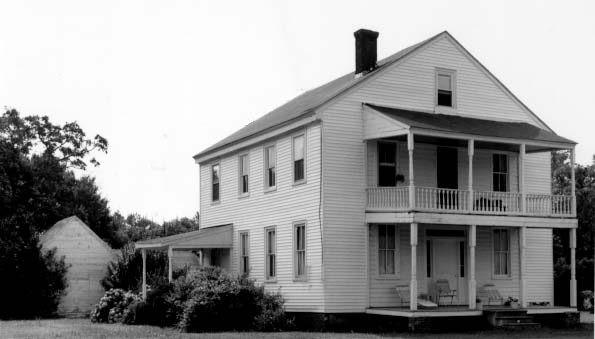
Construction on Liberty Hall was started in 1817 and completed in 1820, probably by George Brickhouse, Sally's father.
In 1841, the county commissioners, wishing to establish a public landing and road at Red Bank, condemned one acre of Sally's land abutting the water's edge, assessing its value at $24. In addition, she was awarded damages of $108, "taking into estimation as well the use of the lands to be laid open for such road as the additional fencing which will thereby be rendered necessary."
Later that same year Sally petitioned the court of Northampton County that her slave George, aged and infirmed, be exempt from taxation. It was so ordered.
Sally lived 47 years as a widow and died of consumption March 22, 1859, at 75 years of age. Since she left no will, the court appointed John A. Carpenter, Sally's grandson, her executor. On the 5th of December, 1860, an inventory of the estate was made. The public sale was held the next day.
In the inventory were many items that she had purchased from her husband's sale many years before. Southy and Sally's daughter, Maria Godwin, herself twice a widow, bought many of the articles. Sally's grandson, Charles A. Carpenter and son-in-law, John H. Floyd also purchased heavily from the sale.
Inventory and sale of the estate of Sally J. Nelson.
Sally Joynes Brickhouse Nelson is buried at the family cemetery at Liberty Hall. Her daughter Maria, and many of Sally's descendants are interred there. Her grave is marked by a plain raised structure of brick topped by a large stone slab inscribed:
In Memory of
SALLY J. NELSON
Wife of
SOUTHY NELSON
and daughter of
Geo. & Mary
BRICKHOUSE
Who departed this life
March 22, 1859
Aged 75 years 6 months & 22 days
Old and full of years she was called from her
large circle of sorrowing relatives and weeping
friends may her entrance into Eternity be
peaceful as her exit was tranquil
So He giveth his beloved sleep.
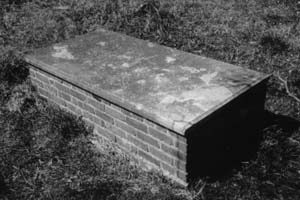
* * * * * * * *
Today on the original land that descended to Southy and his brother John, there stands but a ruin of a twin-chimneyed house on John's portion: only a fraction of the brick end wall and the chimneys remain. The ruin was possibly the original mansion house described as such when deeded to William & John by their mother in 1781. This house was called the "Al Wise House" after a later owner. A small undistinguished house of late nineteenth century construction in very poor condition is there as well.
The grave of Sally J. Brickhouse Nelson
There is the impression that Southy seems to have lived in the shadow of his brother John. For whatever reasons, his mother deeded the land to his brothers before he was born which denied him the legacy of his father's will. After he received half of his brother William's land, it was reapportioned giving John not only three-quarters of the total acreage, but the mansion house too. When his father's estate was finally settled he received less than one-half of John's amount. However, in contrast to his brother, he managed to stay out of debt and never mortgaged his land.
His early death was probably a hard blow to Sally and the children despite the reality that widowhood was a possibility at any time. Even though she had four infant children, Sally was a desirable widow. She had a viable farm and modest wealth. Marrying a widow with property was a quick way to move up financially. Sally knew however, that if she remarried, a division of the property would have to be made, she would loose her independence, and the children would be placed under guardianships. The evidence suggests that Sally was a strong-minded individual who was able to take control and get things done.
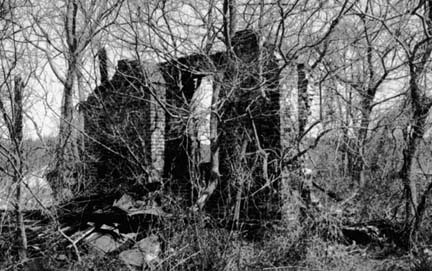
The Al Wise House as it appeared in March of 1996
You are vistor number Thanks for stopping by.
Questions, comments, additions? Will Brown
Return to top of page
Page updated December 23, 2003 (wls)